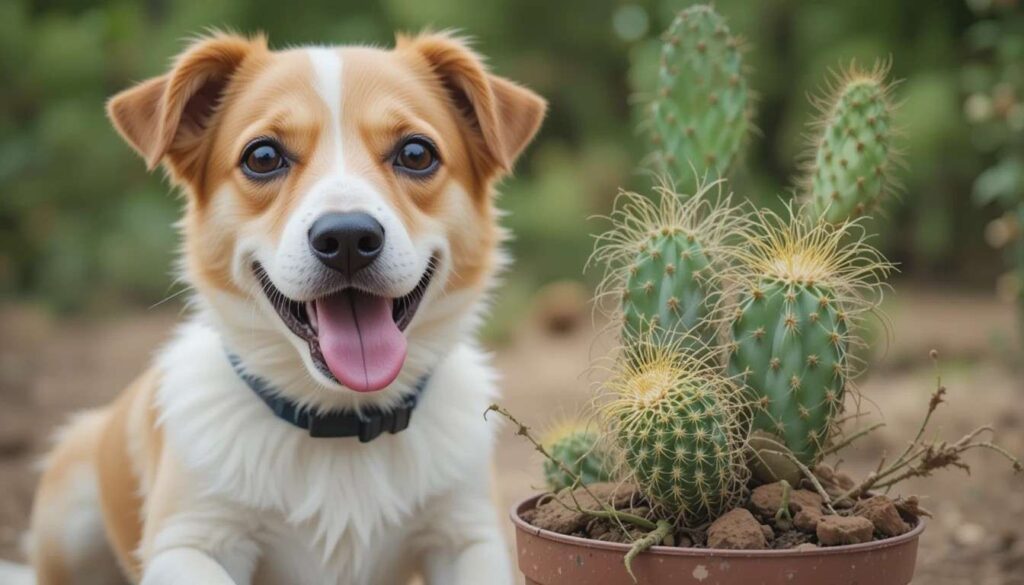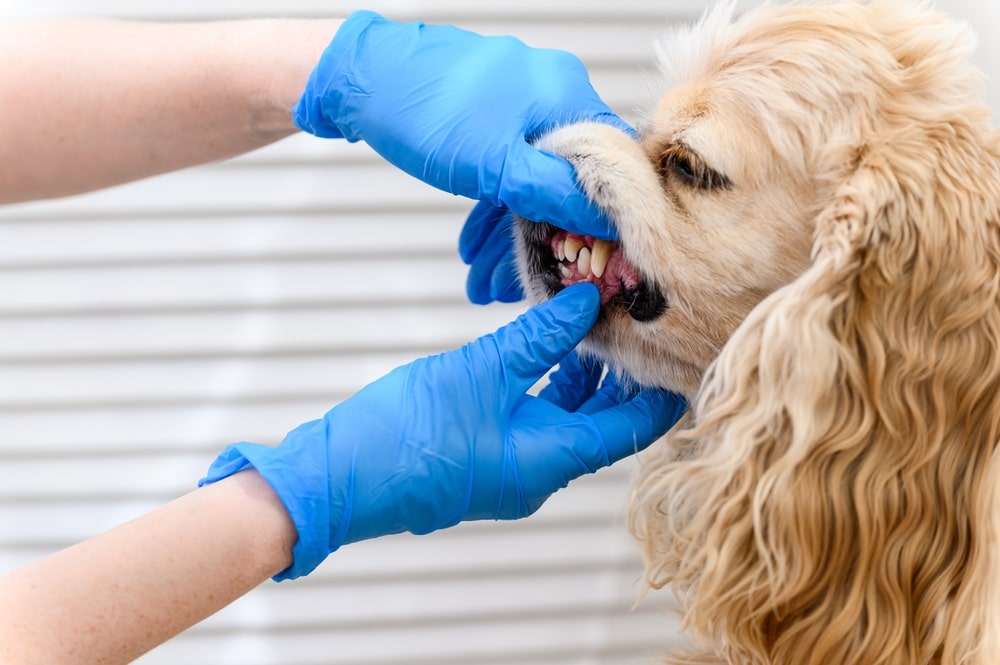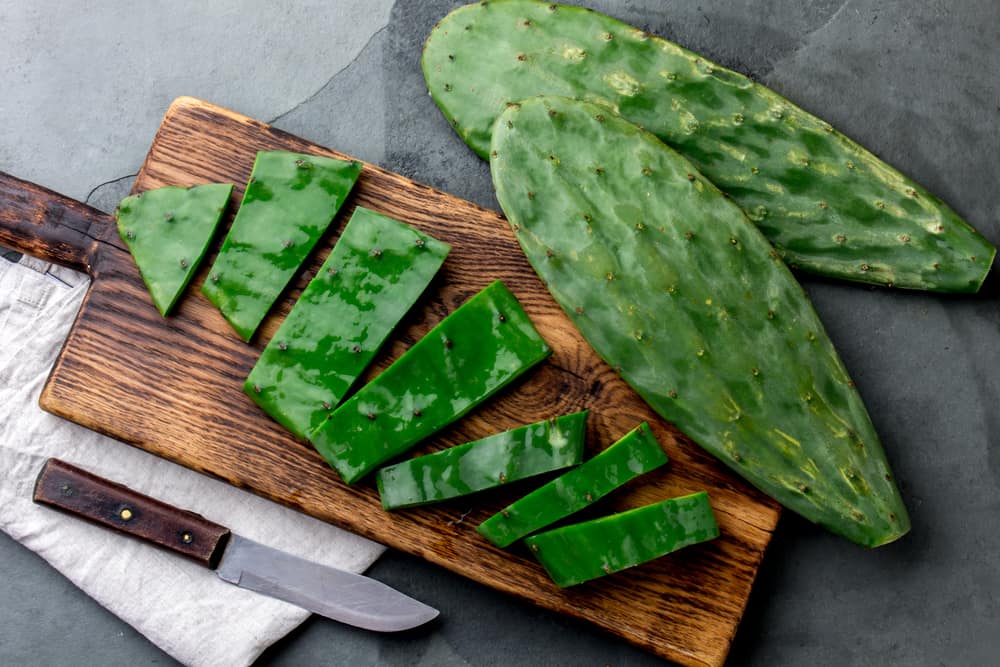Dogs are naturally curious, and sometimes that curiosity leads them straight toward plants we never expect—like cactus. As a pet parent, seeing your dog sniff or nibble at those spiky plants can be worrying.
Dogs should not eat cactus. While prickly pear cactus is considered non-toxic, most cacti have sharp spines and irritating sap that cause injuries or stomach upset. It’s safest to keep all cactus plants away.
In this guide, we’ll explore the risks, symptoms, safe alternatives, and what to do if your dog ever eats cactus.
Cactus isn’t safe for dogs because of its sharp spines and irritating sap. Even if the plant itself isn’t toxic, chewing or swallowing cactus can cause painful mouth injuries, stomach problems, or worse.
Dogs may also get spines stuck in their paws or face just by sniffing. It’s best to keep cactus out of reach and choose safer plants for your home or yard.

Cactus spines can easily pierce a dog’s mouth, tongue, throat, or skin. These sharp points often break into tiny pieces, making them hard to remove and causing ongoing pain or infections.
If swallowed, spines may damage the digestive tract and require surgery. Even playful sniffing can lead to serious injuries. Keeping dogs away from cacti is the simplest way to avoid these painful accidents.
Some cactus species release a sticky, milky sap that irritates dogs’ mouths and stomachs. Ingesting it can cause drooling, nausea, vomiting, or diarrhea.
While most cacti aren’t highly poisonous, the discomfort they cause can be distressing for both you and your pet.
Since it’s hard to know which species are more dangerous, the safest approach is to prevent your dog from chewing or licking any cactus at all.
- Drooling or pawing at the mouth
- Vomiting or diarrhea
- Refusing food or water
- Swelling in the face or mouth
- Blood in vomit or stool
- Trouble breathing or signs of shock (pale gums, lethargy)
These symptoms mean it’s time to get help from a vet.
If you catch your dog chewing cactus:
- Remove visible spines carefully with tweezers.
- Rinse their mouth gently with water.
- Do not induce vomiting — spines can cause more damage on the way up.
- Call your vet immediately for guidance.
Quick, calm action can prevent further injury.

Cactus spines can easily pierce your dog’s skin, mouth, or paws, causing painful wounds or infections.
Even small thorns are hard to remove. Keeping cactus out of reach is the simplest way to avoid these injuries.
If your dog eats cactus, the sap and plant material can irritate their stomach. This often leads to drooling, vomiting, or diarrhea. Even if it’s not life-threatening, it makes your dog uncomfortable and requires quick care.
While not all cacti are poisonous, some release irritating sap that may trigger allergic reactions in dogs.
Signs include swelling, skin irritation, or excessive drooling. To stay safe, it’s best to prevent your dog from eating any cactus.
- Keep cacti out of reach – Place plants on high shelves or in rooms your dog can’t access. Even curious sniffing can cause painful injuries.
- Choose safer plants – Replace cactus with dog-friendly succulents like haworthia or echeveria to avoid risks altogether.
- Use barriers – If you keep cactus outdoors, add fencing, pots, or decorative rocks to block your dog’s access.
- Supervise your dog – Watch your pup during playtime in the yard or when introducing them to new spaces with plants.
- Train “leave it” command – Teaching your dog to ignore unsafe objects provides long-term safety, not just with plants but also with other hazards.
- Check surroundings often – Inspect your home and garden regularly to ensure no fallen spines or broken plant parts are lying around.
Some succulents are safe for dogs, like haworthia, echeveria, and zebra plants. They look beautiful, require little care, and won’t harm your pup if chewed. Always double-check plant safety before bringing one into your home.
If you love the cactus vibe but want pet safety, consider options like the rattail cactus (a safe variety), holiday cactus, or plastic look-alikes. These give you the same desert style without risking your dog’s health or comfort.
Also Read: Can Dogs Eat Takis? – Every Pet Owner Should Must Know

Cacti are unsafe for dogs because they combine sharp spines, irritating sap, and, in some cases, toxic compounds.
Even small bites can cause painful mouth injuries, swelling, or digestive problems. Some species may trigger vomiting or diarrhea, making your dog very uncomfortable.
Since it’s hard to know which cacti are safe or dangerous, the best choice is to treat all cacti as unsafe and prevent your dog from chewing or eating them.
Cooked nopales, also known as prickly pear cactus pads, may seem harmless, but they’re not recommended for dogs.
While cooking removes the sharp spines, nopales can still upset your dog’s stomach and cause diarrhea or vomiting.
The texture and sap can irritate the digestive tract, especially in sensitive dogs. Instead of risking discomfort, it’s better to stick with proven dog-friendly vegetables like carrots or green beans that are safe and nutritious.
Not all cacti are toxic, but some species can be dangerous. The pencil cactus (Euphorbia tirucalli) is especially harmful because its sap is highly irritating and can cause severe mouth pain, drooling, vomiting, and even eye injuries.
Other euphorbia succulents also pose risks. Because many cacti look alike, it’s easy to mistake a toxic type for a safe one. That’s why it’s safest to avoid all cactus plants around your dog.
Cacti may be healthy for humans in some forms, but they don’t provide real benefits for dogs. While they contain water and fiber, the risks from spines, sap, and possible toxins far outweigh any nutrients.
Dogs have no nutritional need for cactus, and eating it only leads to discomfort or danger. Instead, giving safe fruits and vegetables—like blueberries, pumpkin, or cucumbers—offers genuine health benefits without the risks that cactus plants bring.
Must Read: Can Cytopoint Cause Seizures In Dogs – A Complete Guide!
Dogs should not eat raw cactus. The sharp spines and irritating sap can injure the mouth, throat, or stomach.
Even small bites may cause pain, vomiting, or diarrhea. It’s safest to keep raw cactus completely away from your dog.

Nopales, or prickly pear pads, are not recommended for dogs. Even when spines are removed, the plant’s sap may upset digestion and cause diarrhea or stomach pain. Dogs gain no nutritional benefit from nopales, so it’s best to avoid them.
Cooking cactus removes spines, but it still isn’t safe for dogs. The sap and plant fibers can irritate their digestive system, leading to vomiting or diarrhea. Since it doesn’t offer real health benefits, cooked cactus isn’t a safe food choice.
Cactus juice may sound healthy, but it’s unsafe for dogs. The concentrated plant sap can irritate the stomach and cause nausea or diarrhea. Some cactus species are even toxic. Providing fresh water or safe fruits is a much better option.
Cactus seeds are small but not safe for dogs. They can be hard to digest, cause stomach upset, or even create choking risks in small breeds. Since dogs don’t benefit from cactus seeds, it’s best to avoid feeding them.
Cooked nopales are softer but still not safe for dogs. The sap can irritate the digestive system, and the plant doesn’t provide real nutrition for pets. Safer, dog-friendly vegetables like carrots or green beans are a better alternative.
Raw nopales are risky because of their spines and irritating sap. Even if spines are removed, chewing them may cause mouth pain, drooling, or stomach upset. Feeding raw nopales to your dog isn’t safe, so it’s best avoided completely.
You Should Know: How Do You Know If Your Dog Has Parvo: Key Signs to Notice!
Prickly pear seeds are hard for dogs to digest. Eating them may cause stomach upset, constipation, or even blockages in small dogs. Since they don’t add nutritional value, it’s safest to keep prickly pear seeds away.
Seek veterinary help if your dog:
- Shows persistent vomiting or diarrhea
- Has swelling, bleeding, or spines lodged inside the mouth
- Struggles to breathe or seems weak
Even if your dog seems fine, regular vet visits help catch issues early. Ask your vet about desert plant dangers if you live in cactus-heavy areas. Professional advice ensures your pet stays safe and healthy.
Most succulents aren’t safe for dogs. Some are toxic and others cause stomach upset, so avoid letting your pup chew them.
No cactus is truly safe for dogs. Spines, sap, and toxins make them risky. It’s best to avoid all cacti.
Stay calm, remove visible spines, and call your vet. Quick treatment prevents infections, stomach issues, or dangerous complications from cactus ingestion.
Mexican cactus, like nopales, isn’t safe for dogs. Even cooked, it may upset digestion and offer no real health benefits.
Thorns can pierce the mouth, throat, or stomach, causing pain and possible infections. Veterinary care is essential if your dog swallows thorns.
Cactus plants aren’t dog-friendly. Sharp spines and irritating sap make them unsafe. Choose safer, non-toxic plants for a pet-friendly home environment.
Check for injuries, keep your dog calm, and contact a vet immediately. Professional care helps prevent infection, pain, and serious complications.
Sago palm is among the most toxic plants for dogs. Even small amounts can cause liver failure, seizures, or death.
Yes, agave is poisonous to dogs. Its sap can burn the skin, irritate the mouth, and cause vomiting or diarrhea.
Grass itself isn’t toxic, but pesticides or chemicals on it can harm dogs. Always avoid treated lawns during walks.
Cactus and dogs don’t mix. From painful spines to irritating sap, these plants bring more risks than benefits. The safest choice is to keep cacti away and offer dog-friendly foods and safe plants instead. If your pup ever eats cactus, act quickly and call your vet. With awareness and prevention, you’ll keep your furry friend happy and safe.
